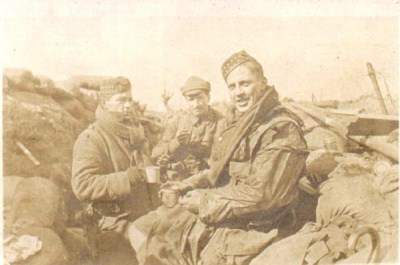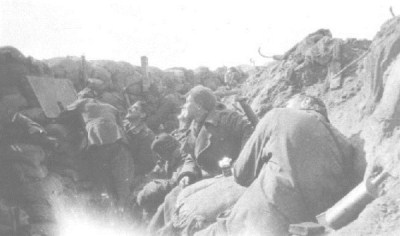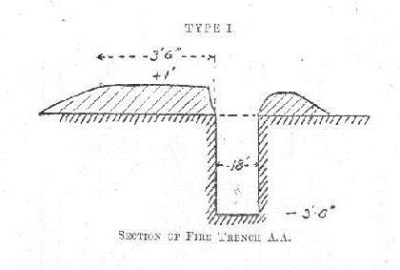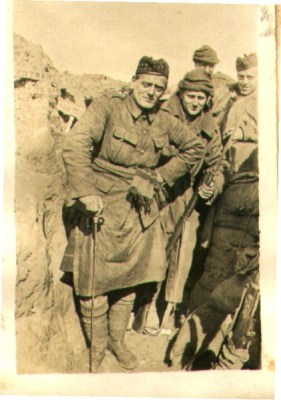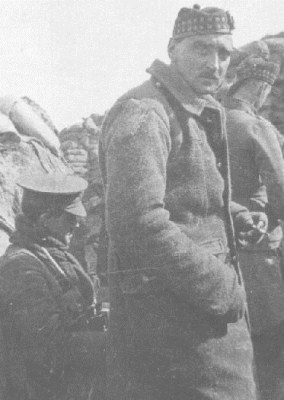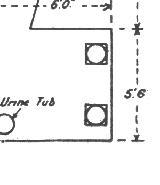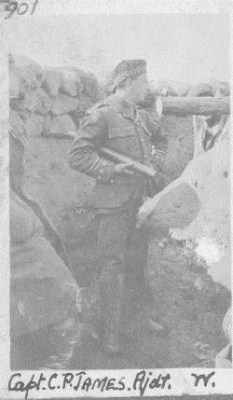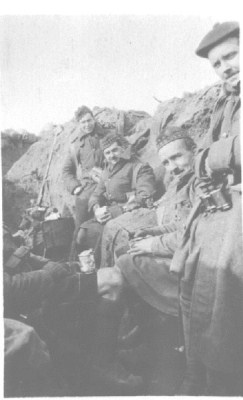The CO and the grenade
The Evidence of Trench Life - Early 1915
The Rifle Grenade - Ypres Salient, Spring1915
 This is a photograph which is part of a series which were taken in Ypres Salient, probably in reserve trenches but very close to the front line. The presence of cameras in the front line was strictly forbidden but Private F.A. Fyfe, a press photographer by profession, certainly used his miniature camera in the front line as the rare photographs taken under fire during the charge at Hooge i n June 1915 demonstrate. The man who took these photos (very possibly Captain R.F.B. Dickinson) must have been close to the Commanding Officer, Lt.Col. R Davidson, as the CO features in many of them. This series of photos had quite a wide distribution amongst the men of the battalion as surviving albums (including Captain Dickinson's own album) in the Museum demonstrate.
This is a photograph which is part of a series which were taken in Ypres Salient, probably in reserve trenches but very close to the front line. The presence of cameras in the front line was strictly forbidden but Private F.A. Fyfe, a press photographer by profession, certainly used his miniature camera in the front line as the rare photographs taken under fire during the charge at Hooge i n June 1915 demonstrate. The man who took these photos (very possibly Captain R.F.B. Dickinson) must have been close to the Commanding Officer, Lt.Col. R Davidson, as the CO features in many of them. This series of photos had quite a wide distribution amongst the men of the battalion as surviving albums (including Captain Dickinson's own album) in the Museum demonstrate.
The Commanding Officer: Lt Colonel JR Davidson is on the right of the picture firing a rifle grenade. Colonel Davidson's diary records that on the 20th March 1915 he went up to 38 Trench at Hill 60 (near Ypres/Ieper) to inspect a new loophole and he that he 'fired about 12 rifle grenades with a fair degree of success. He appears to be caught at the moment of firing the grenade as others in he group appear to be following its path through the air.
Rifle Barrel: The barrel of the rifle is by his left shoulder and he is trying to keep his head below the level of the muzzle (the business end of the rifle) to avoid the effects of the blast).
Personalities: Left to right the personalities are Capt. CP James (Adjutant and observing through armoured slit), to the immediate right is Capt. AS Anderson (Company Commander), an unknown private, Lt. Kenneth Gemmell and Lt Col JR Davidson.
Headdress: Soldiers are in a mixture of headdress and while most men are wearing the official glengarries with the diced (chequered) band, one is wearing the more practical woollen 'cap-comforter' which were already appearing by November 1914. The steel helmet was not introduced until later in the war and even then it was difficult to persuade soldiers to wear them.
Periscope: There are two 'trench periscopes' being used in the centre and they can be seen sticking up over the top of parapet. T he adjutant's (to the left) is in the form of a circular tube whilst the other seems to be a rectangular tube.
Armoured Loophole: To the left is a metal sheet with a slot cut in the bottom; this is an armoured loophole to allow a rifle to be fired with protection to the firer. There were a variety of methods of protecting observation points and loopholes. Soldiers appear to be watching to their front and to a point above them; a rifle grenade is being fired by the man in the right foreground who is, in fact, the Commanding Officer
Water Bottle: A water bottle can be seen to the bottom right; supplies of drinking water were a great problem particularly in the early days of trench warfare when there were very few communication trenches. However, at hill 60 the Liverpool Scottish so improved their position that it was possible to move the 400 yards between battalion HQ (dug into the banked sides of the Ypres to Comines railway line) and the front line positions.
Link to each page by clicking the images below.
Previous page: Early Spring 1915
Next page: The Trench System 1914

